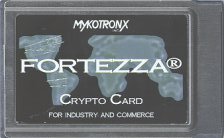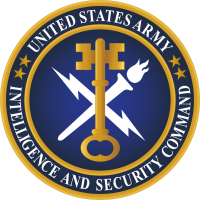Related Research Articles

The National Security Agency (NSA) is a national-level intelligence agency of the United States Department of Defense, under the authority of the Director of National Intelligence (DNI). The NSA is responsible for global monitoring, collection, and processing of information and data for foreign and domestic intelligence and counterintelligence purposes, specializing in a discipline known as signals intelligence (SIGINT). The NSA is also tasked with the protection of U.S. communications networks and information systems. The NSA relies on a variety of measures to accomplish its mission, the majority of which are clandestine. The existence of the NSA was not revealed until 1975. The NSA has roughly 32,000 employees.

Communications security is the discipline of preventing unauthorized interceptors from accessing telecommunications in an intelligible form, while still delivering content to the intended recipients.

The Defense Information Systems Agency (DISA), known as the Defense Communications Agency (DCA) until 1991, is a United States Department of Defense (DoD) combat support agency composed of military, federal civilians, and contractors. DISA provides information technology (IT) and communications support to the President, Vice President, Secretary of Defense, the military services, the combatant commands, and any individual or system contributing to the defense of the United States.

The Defense Intelligence Agency (DIA) is an intelligence agency and combat support agency of the United States Department of Defense, specializing in defense and military intelligence.

During the 2003 invasion of Iraq by a United States–led coalition, the U.S. Defense Intelligence Agency developed a set of playing cards to help troops identify the most-wanted members of President Saddam Hussein's government, mostly high-ranking members of the Iraqi Regional Branch of the Arab Socialist Ba'ath Party or members of the Revolutionary Command Council; among them were some of Hussein's family members. The cards were officially named the "personality identification playing cards". As of 2021, all but four of the 52 most wanted have died or been either killed or captured, eleven of whom have been released.
AIS may refer to:
X.400 is a suite of ITU-T recommendations that define the ITU-T Message Handling System (MHS).

The Central Security Service (CSS) is a combat support agency of the United States Department of Defense which was established in 1972 to integrate the National Security Agency (NSA) and the Service Cryptologic Components (SCC) of the United States Armed Forces in the field of signals intelligence, cryptology, and information assurance at the tactical level. In 2002, the CSS had approximately 25,000 uniformed members. It is part of the United States Intelligence Community.

Fortezza is an information security system that uses the Fortezza Crypto Card, a PC Card-based security token. It was developed for the U.S. government's Clipper chip project and has been used by the U.S. Government in various applications.
The Defense Message System or Defense Messaging System (DMS) is a deployment of secure electronic mail and directory services in the United States Department of Defense. DMS was intended to replace the AUTODIN network, and is based on implementations of the OSI X.400 mail, X.500 directory and X.509 public key certificates, with several extensions to meet the specific needs of military messaging.

The DMS-100 is a member of the Digital Multiplex System (DMS) product line of telephone exchange switches manufactured by Northern Telecom. Designed during the 1970s and released in 1979, it can control 100,000 telephone lines.
Military Message Handling System (MMHS) is a profile and set of extensions to X.400 for messaging in military environments. It is NATO standard STANAG 4406 and CCEB standard ACP 123. It adds to standard X.400 email support for military requirements such as mandatory access control. In particular it defines a new message format, P772 that is used in place of X.400's interpersonal message formats P2 and P22.

Military communications or military signals involve all aspects of communications, or conveyance of information, by armed forces. Examples from Jane's Military Communications include text, audio, facsimile, tactical ground-based communications, naval signalling, terrestrial microwave, tropospheric scatter, satellite communications systems and equipment, surveillance and signal analysis, security, direction finding and jamming. The most urgent purposes are to communicate information to commanders and orders from them.
The Defense Information System Network (DISN) has been the United States Department of Defense's enterprise telecommunications network for providing data, video, and voice services for 40 years.
Air Traffic Services Message Handling Services (AMHS) is a standard for aeronautical ground-ground communications based on X.400 profiles. It has been defined by the ICAO.
A service system is a configuration of technology and organizational networks designed to deliver services that satisfy the needs, wants, or aspirations of customers. "Service system" is a term used in the service management, service operations, services marketing, service engineering, and service design literature. While the term frequently appears, it is rarely defined.

The United States Army Intelligence and Security Command (INSCOM) is a direct reporting unit that conducts intelligence, security, and information operations for United States Army commanders, partners in the Intelligence Community, and national decision-makers. INSCOM is headquartered at Fort Belvoir, Virginia.

Telos Corporation is an information technology and cybersecurity company located in Ashburn, Virginia. Telos primarily serves government and enterprise clients, receiving a large number of its contracts from the United States Department of Defense. Customers are primarily military, intelligence and civilian agencies of the US government and NATO allies.
Document Capture Software refers to applications that provide the ability and feature set to automate the process of scanning paper documents or importing electronic documents, often for the purposes of feeding advanced document classification and data collection processes. Most scanning hardware, both scanners and copiers, provides the basic ability to scan to any number of image file formats, including: PDF, TIFF, JPG, BMP, etc. This basic functionality is augmented by document capture software, which can add efficiency and standardization to the process.
Geographic information systems (GIS) play a constantly evolving role in geospatial intelligence (GEOINT) and United States national security. These technologies allow a user to efficiently manage, analyze, and produce geospatial data, to combine GEOINT with other forms of intelligence collection, and to perform highly developed analysis and visual production of geospatial data. Therefore, GIS produces up-to-date and more reliable GEOINT to reduce uncertainty for a decisionmaker. Since GIS programs are Web-enabled, a user can constantly work with a decision maker to solve their GEOINT and national security related problems from anywhere in the world. There are many types of GIS software used in GEOINT and national security, such as Google Earth, ERDAS IMAGINE, GeoNetwork opensource, and Esri ArcGIS.
References
- ↑ "DoDIIS 2010". Archived from the original on 2010-12-26. Retrieved 2010-06-07.
- ↑ Janes